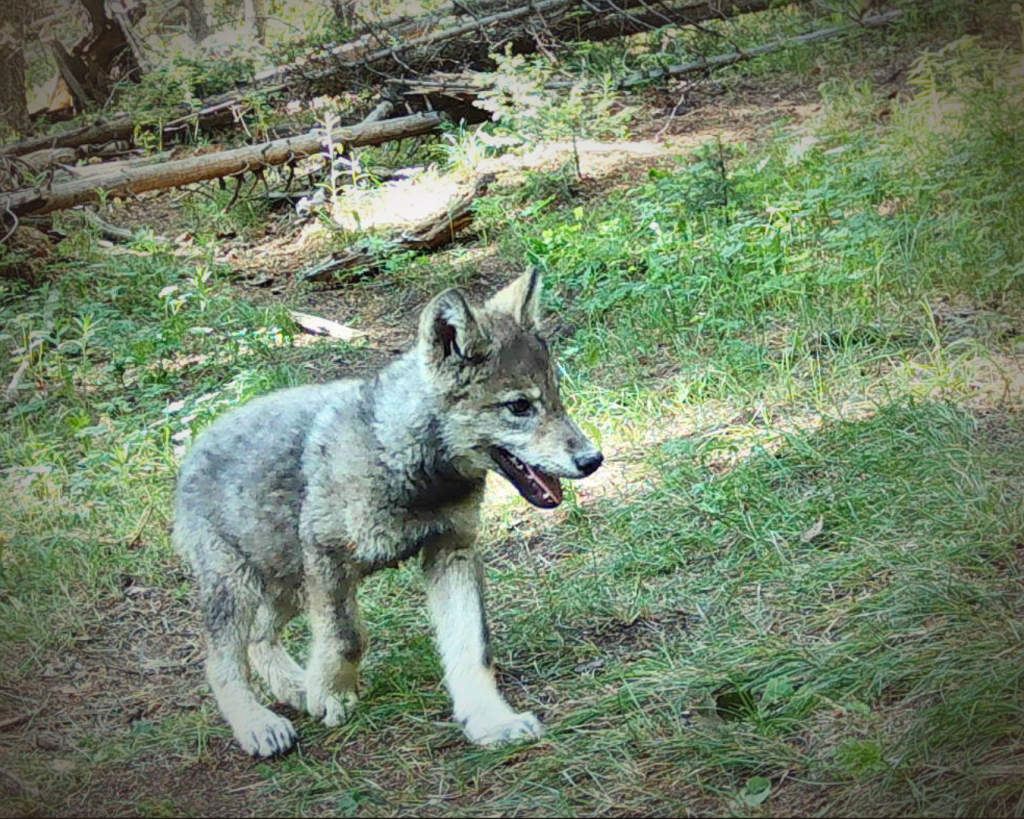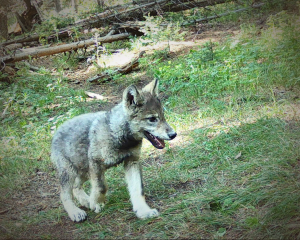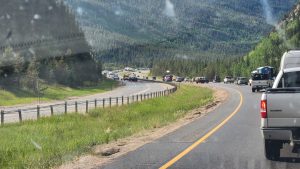WATCH: Colorado Parks and Wildlife shares first footage of state’s newest wolf pups
Pups are beginning to emerge from four den sites in northwest Colorado
Earlier this week, Colorado Parks and Wildlife confirmed and released the names of three new wolf packs in northwest Colorado.
At its Thursday commissioner meeting, staff shared the first photo and video of pups born to the King Mountain Pack in Routt County. The pups were born around mid-April and were captured by Parks and Wildlife trail cameras around June 22, according to Eric Odell, the agency’s wolf program manager.
Odell said that while it is hard to get an exact count on the number of pups in the pack, they have identified at least four in the King Mountain group. The genders are unknown.
At around 10 to 12 weeks old, Odell said the pups are likely done nursing but are still tied very closely to the den or “rendezvous site.”
“They’re not at the point where they can travel with a pack, but they are out and about,” Odell said.
The King Mountain Pack is one of three packs created by Colorado’s reintroduced wolves this year. This also includes the One Ear Pack in western Jackson County and the Three Creeks Pack in Rio Blanco County. A pack is officially established once a breeding pair has pups, according to Odell.
The state’s fourth pack, the Copper Creek Pack, also had additional pups in Pitkin County this spring. This pack was initially established in 2024 in Grand County. The pack’s original patriarch died from injuries connected to a gunshot wound after the pack was captured and placed in a wildlife sanctuary, following a series of livestock attacks in Grand County.
Four of the pack’s original pups were released with the adult female in January. Shortly after, the matriarch bred and had additional pups with one of the adult male wolves, 2503, brought to Colorado from British Columbia this year.
In addition to the breeding pair and an unknown number of pups, the pack has three yearlings from the original den. One of the yearlings was killed by Parks and Wildlife in May after the pack was connected to repeated livestock attacks.

While the pack is no longer in the Copper Creek region, Odell addressed why the pack — with a new patriarch and den location — still carries its original name on Thursday.
“It is the same animals; it’s the same breeding female and the same pups, yearlings now that were part of that litter in 2024,” Odell said. “I’m certain that there would have been criticisms of not being transparent if we tried to rename that pack, too.”
While Parks and Wildlife staff are actively monitoring all four dens, Odell said the agency does not have pup counts for every site yet.
“Pups are just inherently difficult to monitor at this time of the year,” he said. “They’re small. Up until about now, they’re tied very closely to the den in deep cover.”
On average, wolf packs will have between four to six pups in a single litter, but survival can be low, Odell said.
“Pup mortality is very high,” he said. “We certainly can’t expect that all of those animals, maybe about half of those animals, will survive through the year.”
Once born, the surviving pups typically stay with their pack for the first year, Odell noted.
While the Copper Creek Pack has been shrouded in controversy and involved in many of the state’s confirmed livestock depredations, Colorado’s other three packs have had “minimal conflicts to date,” according to Brian Dreher, assistant director of Parks and Wildlife’s terrestrial wildlife branch.
“This may be attributed to multiple factors, not least of which is the participation and coordination with ranchers in these areas and (Parks and Wildlife) staff, (Colorado Department of Agriculture) staff, and range riders,” Dreher said. ‘We fully recognize that that situation could change any time and we can’t just rest on that. We need to stay vigilant and adapt to whatever kind of gets thrown our direction.”
Dreher shared what resources and conflict minimization tools have been deployed in the regions where each of Colorado’s packs currently reside.
While the exact methods differ based on the situation, these tools included combinations of range riders from Parks and Wildlife and the Department of Agriculture, damage specialists hired specifically for the wolf restoration, support from the U.S. Forest Service with use of a ranger station in the case of the King Mountain Pack, livestock monitoring, emerging scare device technology in partnership with Colorado State University and more.
This pack creation and reproduction marks a “key point” in Colorado’s restoration of gray wolves, Odell told commissioners.
“Despite some things that you may hear, not all aspects of wolf management have been a failure,” he said.
Odell added that while there have been challenges of wolf restoration on producers, staff and wolves, it has been a success so far.
“We knew that there was going to be conflict; we knew that there would be dead wolves, and we knew that there would be wolf reproduction. These are all landmarks that are important parts in the whole effort of wolf restoration. Nothing is a surprise,” Odell added. “I think we’re working toward success in many different ways — not just from a wolf population side of things, but from a producer perspective as well.”

Support Local Journalism

Support Local Journalism
As a Summit Daily News reader, you make our work possible.
Summit Daily is embarking on a multiyear project to digitize its archives going back to 1989 and make them available to the public in partnership with the Colorado Historic Newspapers Collection. The full project is expected to cost about $165,000. All donations made in 2023 will go directly toward this project.
Every contribution, no matter the size, will make a difference.








